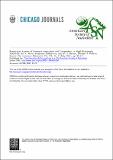| dc.contributor.author | Dutkiewicz, Stephanie | |
| dc.contributor.author | Barton, Andrew D. | |
| dc.contributor.author | Ward, Ben | |
| dc.contributor.author | Follows, Michael J | |
| dc.date.accessioned | 2015-07-22T18:06:07Z | |
| dc.date.available | 2015-07-22T18:06:07Z | |
| dc.date.issued | 2011-06 | |
| dc.date.submitted | 2010-11 | |
| dc.identifier.issn | 00030147 | |
| dc.identifier.issn | 15375323 | |
| dc.identifier.uri | http://hdl.handle.net/1721.1/97884 | |
| dc.description.abstract | Mixotrophic organisms combine autotrophic and heterotrophic nutrition and are abundant in both freshwater and marine environments. Recent observations indicate that mixotrophs constitute a large fraction of the biomass, bacterivory, and primary production in oligotrophic environments. While mixotrophy allows greater flexibility in terms of resource acquisition, any advantage must be traded off against an associated increase in metabolic costs, which appear to make mixotrophs uncompetitive relative to obligate autotrophs and heterotrophs. Using an idealized model of cell physiology and community competition, we identify one mechanism by which mixotrophs can effectively outcompete specialists for nutrient elements. At low resource concentrations, when the uptake of nutrients is limited by diffusion toward the cell, the investment in cell membrane transporters can be minimized. In this situation, mixotrophs can acquire limiting elements in both organic and inorganic forms, outcompeting their specialist competitors that can utilize only one of these forms. This advantage can be enough to offset as much as a twofold increase in additional metabolic costs incurred by mixotrophs. This mechanism is particularly relevant for the maintenance of mixotrophic populations and productivity in the highly oligotro phic subtropical oceans. | en_US |
| dc.description.sponsorship | United States. National Aeronautics and Space Administration | en_US |
| dc.description.sponsorship | Gordon and Betty Moore Foundation | en_US |
| dc.language.iso | en_US | |
| dc.publisher | University of Chicago Press | en_US |
| dc.relation.isversionof | http://dx.doi.org/10.1086/660284 | en_US |
| dc.rights | Article is made available in accordance with the publisher's policy and may be subject to US copyright law. Please refer to the publisher's site for terms of use. | en_US |
| dc.source | MIT web domain | en_US |
| dc.title | Biophysical Aspects of Resource Acquisition and Competition in Algal Mixotrophs | en_US |
| dc.type | Article | en_US |
| dc.identifier.citation | Ward, Ben A., Stephanie Dutkiewicz, Andrew D. Barton, and Michael J. Follows. “Biophysical Aspects of Resource Acquisition and Competition in Algal Mixotrophs.” The American Naturalist 178, no. 1 (July 2011): 98–112. © 2011 The University of Chicago | en_US |
| dc.contributor.department | Massachusetts Institute of Technology. Center for Global Change Science | en_US |
| dc.contributor.department | Massachusetts Institute of Technology. Department of Earth, Atmospheric, and Planetary Sciences | en_US |
| dc.contributor.mitauthor | Ward, Ben A. | en_US |
| dc.contributor.mitauthor | Dutkiewicz, Stephanie | en_US |
| dc.contributor.mitauthor | Barton, Andrew D. | en_US |
| dc.contributor.mitauthor | Follows, Michael J. | en_US |
| dc.relation.journal | The American Naturalist | en_US |
| dc.eprint.version | Final published version | en_US |
| dc.type.uri | http://purl.org/eprint/type/JournalArticle | en_US |
| eprint.status | http://purl.org/eprint/status/PeerReviewed | en_US |
| dspace.orderedauthors | Ward, Ben A.; Dutkiewicz, Stephanie; Barton, Andrew D.; Follows, Michael J. | en_US |
| dc.identifier.orcid | https://orcid.org/0000-0002-3102-0341 | |
| mit.license | PUBLISHER_POLICY | en_US |
| mit.metadata.status | Complete | |
